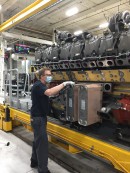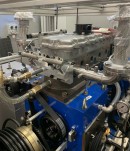The European automotive industry has been edgy over the past few months. Petrol heads are not a happy bunch. The fate of their favorite gas-hungry engines is coming to an end. The future of the internal combustion engine in the trading bloc depends on the impending Euro 7 emissions regulations. Well, the day of reckoning is here, as the European Union is set to make public the awaited emission rules on Thursday.
Based on a document obtained by Bloomberg News, the EU will announce the regulations governing the Euro 7 engine. These will be the last breed of gasoline and diesel engines that will hit the market before the 2035 ICE ban. After which, they'll be rendered obsolete.
The new legislation, part of the European Green Deal, is expected to tighten restrictions on emissions, including carbon monoxide and nitrogen oxides, on gas-powered cars, vans, buses, and lorries from 2025. It aims to place the continent's economy on a sustainable footing
The announcement is expected to arrive after a lengthy push and pull over the contents of the regulations.
Environmentalist groups such as the NGO Transport & Environment have not been happy with the delays or the possibility that the rules could be watered-down in favor of auto manufacturers and at the cost of the continent's health.
They feel that vehicles produced between 2025 and 2035 (ICE ban year) will exist in the used-car market for decades.
Car manufacturers, on the hand, argue that the recent steps in cutting down carbon monoxide could put unnecessary strain on the industry and, as a result, slow down the shift into electrification of their fleets.
According to the contents of the draft, the transition to zero-emission automobiles will spread across at least two decades, not least given the average lifetime of a vehicle of more than 11 years.
"Meanwhile, in order to achieve the above policy objectives, the internal combustion-engine vehicles which will continue to be placed on the market need to be as clean as possible." The draft read.
The long-awaited decision on the Euro 7 engine comes after the commission reached a deal to ban ICEs from 2035.
The new legislation, part of the European Green Deal, is expected to tighten restrictions on emissions, including carbon monoxide and nitrogen oxides, on gas-powered cars, vans, buses, and lorries from 2025. It aims to place the continent's economy on a sustainable footing
The announcement is expected to arrive after a lengthy push and pull over the contents of the regulations.
Environmentalist groups such as the NGO Transport & Environment have not been happy with the delays or the possibility that the rules could be watered-down in favor of auto manufacturers and at the cost of the continent's health.
They feel that vehicles produced between 2025 and 2035 (ICE ban year) will exist in the used-car market for decades.
Car manufacturers, on the hand, argue that the recent steps in cutting down carbon monoxide could put unnecessary strain on the industry and, as a result, slow down the shift into electrification of their fleets.
According to the contents of the draft, the transition to zero-emission automobiles will spread across at least two decades, not least given the average lifetime of a vehicle of more than 11 years.
"Meanwhile, in order to achieve the above policy objectives, the internal combustion-engine vehicles which will continue to be placed on the market need to be as clean as possible." The draft read.
The long-awaited decision on the Euro 7 engine comes after the commission reached a deal to ban ICEs from 2035.
EU to propose Euro 7 rules for last generation of combustion engines https://t.co/zLXwTDRnvl pic.twitter.com/8NFMZvZUnq
— AutoNews Europe (@AutoNewsEurope) November 10, 2022




















